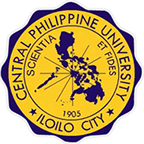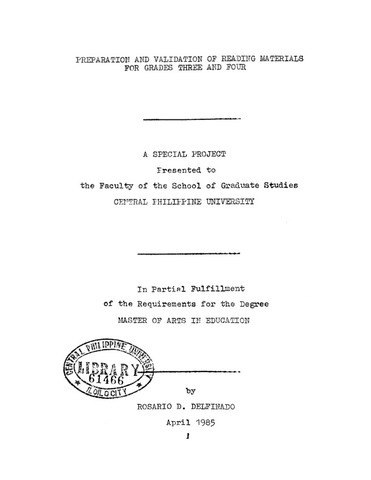Preparation and validation of reading materials for grades three and four
| dc.contributor.author | Delfinado, Rosario D. | |
| dc.date.accessioned | 2021-09-20T03:26:39Z | |
| dc.date.available | 2021-09-20T03:26:39Z | |
| dc.date.issued | 1985 | |
| dc.identifier.citation | Delfinado, R. D. (1985). Preparation and validation of reading materials for grades three and four (Unpublished Master’s special paper). Central Philippine University, Jaro, Iloilo City. | en_US |
| dc.identifier.uri | https://hdl.handle.net/20.500.12852/1404 | |
| dc.description | Introduction and statement of the problem | en_US |
| dc.description.abstract | Introduction Reading is acquired through interaction with printed materials, the teacher, and the environment. These three can he interpreted as constituting a framework within which classroom and reading teachers may begin to improve reading achievement among their pupils. However, the difficulty seems to the one of matching appropriate materials to learners. Persons who are supposed to match materials and the learners but fail to do so may then be one of the causes of reading problems. Here in the Philippines, a huge mass of reading materials is produced and distributed annually among school children. However, there are also textbooks which gather dust in corners for some reasons cited by teachers: vocabulary is culture bound, stories are too long for the usual time allotted to reading, and content of selections is not within the experiences of pupils in Western Visayas. Such textbooks can be helpful. If a pupil's skills in word recognition and comprehension are to be developed, this is better done through stories within his interest, preferences, and experiences. Statement of the Problem The purpose of this study was to prepare six reading materials for grades three and four, that is, three materials for each grade. Specifically, the study aimed to answer the following questions: 1. How valid and appropriate are the prepared reading materials? 2. How reliable are the reading exercises that go with the reading selections? | en_US |
| dc.format.extent | 140 leaves | en_US |
| dc.language.iso | en | en_US |
| dc.subject.ddc | GSL Theses 378.242 D3775 1985 | en_US |
| dc.subject.lcsh | Reading--Aids and devices | en_US |
| dc.subject.lcsh | Reading--Aids and devices--Evaluation | en_US |
| dc.subject.lcsh | Reading (Elementary) | en_US |
| dc.subject.lcsh | Reading (Elementary)--Ability testing | en_US |
| dc.subject.lcsh | Children--Books and reading | en_US |
| dc.title | Preparation and validation of reading materials for grades three and four | en_US |
| dc.title.alternative | Preparation and validation of reading materials for grades 3 and 4 | en_US |
| dc.type | Special paper | en_US |
| dc.description.bibliographicalreferences | Includes bibliographical references | en_US |
| dc.contributor.chair | Herradura, Elma S. | |
| dc.contributor.committeemember | Cang, Febe A. | |
| dc.contributor.committeemember | Ruiz, Macario B. | |
| dc.contributor.committeemember | Griño, Eliza U. | |
| dc.contributor.committeemember | Stanford, Winnifred | |
| dc.contributor.committeemember | Porter, Josefina Y. | |
| dc.contributor.committeemember | Traviña, Miriam M. | |
| dc.contributor.department | School of Graduate Studies | en_US |
| dc.description.degree | Master of Arts in Education | en_US |


